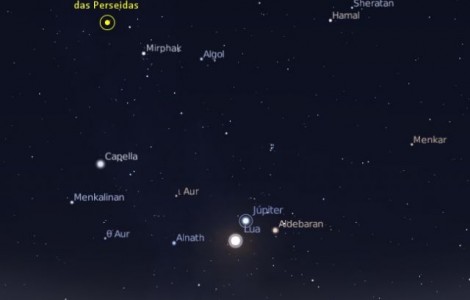 Saint Lawrence (or Lawrence of Huesca), martyr and one of the first seven Deacons (guardians of the treasure) of the Catholic Church, perished on a burning grill, under the order of the Roman Emperor, on August 10, 258, in the eternal city .
Saint Lawrence (or Lawrence of Huesca), martyr and one of the first seven Deacons (guardians of the treasure) of the Catholic Church, perished on a burning grill, under the order of the Roman Emperor, on August 10, 258, in the eternal city .
I don't know whether this date is according to the Julian or Gregorian calendar, but I lean more towards the latter. Not because this is the calendar we follow here in the West, but because the 10th of August, when the Catholic liturgical feast is celebrated in honor of the Christian martyr, is among the days when it is possible to observe a greater intensity and number of shooting stars crossing the zenith on warm summer nights.
It is that popular tradition named the rain of stars, which these days dazzle the starry vault, by the tears of São Lourenço.
The overlap between the date of his death and the astronomical event makes me place the beginning of popular attribution after 1582, the year in which Pope Gregory XIII promulgated the calendar with his name.
In other words, it was only in the summer of 1583 that our planet Earth, in its inexorable translation around the Sun, sublimated a swarm of meteors called the Perseid Cloud between the 8th and 14th of August in the Gregorian calendar.
Just out of curiosity, let's say that the 10th of August in our calendar would be the 28th of July in the Julian calendar.
And the 12th of August, when a peak in the “percipitation” of shooting stars known as Perseids is predicted, would correspond to the 30th of July, according to Julius Caesar.
But let us look a little at the starry sky and let ourselves be bathed in cosmic dust. A shooting star, despite its name, is not a star that suddenly accelerates, leaving a trail behind it for our wonder.
It is actually a meteoroid that entered the Earth's atmosphere and that, due to friction, caused a meteor to sublimate a desire of a persistent observer.
But on the 12th, with a maximum at noon (!), you will need to get up at dawn to impress your retina with meteoric movement when looking at the celestial vault.
This is because planet Earth crosses, at this time of year, a region of interplanetary space dotted with meteoroids, little larger than a pea, and which sprinkle the path taken by the tail of the giant periodic comet Swift-Tuttle (about 28 km in diameter !) in its orbit around the Sun, which takes 133 Earth years (here)!
The first observation record of the passage of the comet is of Chinese origin and dates from 69 BC The last occurred in 1992, the date of its rediscovery.
As with any other comet, when it approaches the Sun, the Dantesque increase in temperature causes small fragments of the comet's nucleus to break off and become trapped in the trajectory of its orbit.
These days, our planet crosses the meteoroid trail of Swift-Tuttle's orbit, and an observer in the northern hemisphere will have the sensation of contemplating a meteor shower that seems to gush from a single source (the radiant one) in the celestial sphere, close to the constellation of Perseus.
It is common to see a hundred meteors volatilize within an hour, scratching the vault at an average entry speed of 212.400 km/h (Lisbon Astronomical Observatory data).
This year, aided by the discretion of the Quarter Moon, good conditions are expected for observing the tears of São Lourenço, at an average estimate of 110 per hour.
But you will have to get up early or, it should be noted, take advantage of the next two nights, which should be the best times to observe this phenomenon.
Antonio Piedade
Science in the Regional Press


















Comments